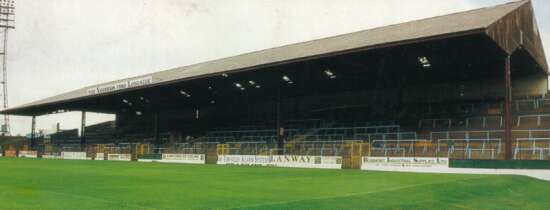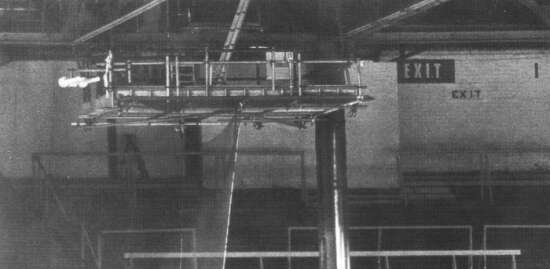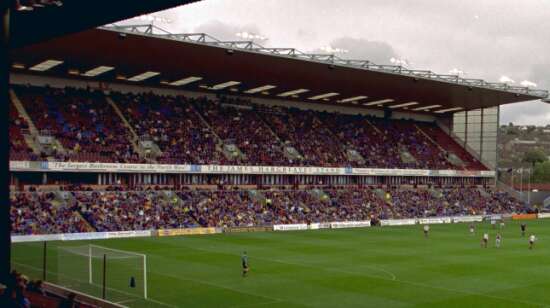|
That was perhaps something of a surprise when you consider that for many years it was nothing but a bit of terracing and not even known as the Longside, in fact I‘m not sure when that name came into being. Certainly it was not the case when I first became a Turf Moor regular. Then, in the 1960s, the Cricket Field End was the place to be and the side terrace was then known as the Popular Side.
I definitely graduated as a Cricket Field Ender, brought up with great chants such as ‘We all agree, Thomson is better than Yashin’ and ‘Singing I I Irvine Irvine I.' You needed to get in there long before 2:30 and the atmosphere was electric.
In those days many fans used to stand behind whichever goal Burnley were attacking (we were so good most of the play would be at that end) and the Popular Side was always an interesting sight at half time as fans used it to make their way from one end to the other. It was possible then to walk around three sides of the ground, just the Brunshaw Road enclosure was out of bounds, it cost a few extra pence to stand in there.
Then they took the Cricket Field End away from us to build a new stand. It took some time for everyone to get themselves sorted and decide where next and finally a section at the back of the Popular side was chosen. At some stage the name Longside appeared and for almost thirty years that was it.
It was THE place to be for noise, it was THE place to be for atmosphere and unfortunately for some time it was THE place to be if you preferred fighting to actually watching the Clarets. My first experience of hooliganism was at Charlton in 1971 when the walk back to the coach became more of a record breaking sprint to avoid the bricks. That sort of thing was soon to arrive on the Longside.
There were indeed some moments in there that I have no wish to repeat and on one occasion, against Newcastle, some opposition fan managed to stick a dart in my dad’s head. We won the game so my dad was not too worried.
Fencing went up eventually to separate us, the first introduction of segregation at Turf Moor and then the "No man’s land" was introduced. Neither of these stopped Celtic in 1978 though in what has to be the most frightening time ever in there. Thankfully another introduction, the perimeter fencing, was not in place then otherwise the problems that night could have been far worse.
That match though did bring about the introduction of the wire fence that was placed from the top of the dividing fence to the roof to prevent the throwing of missiles. It made the place look like Beirut but never did the fans even consider moving.
|
There were great times on the Longside, Sunderland in 1973 and promotion back to the First Division. Chesterfield in 1982 and the 3rd Division Championship and the 4th Division Championship presentation of 1992 despite the defeat.
If I felt a little less affection for it than some then that all changed on 9th May 1987 and the visit of Orient. We were shoved in like sardines in a tin that afternoon and it was the most incredible, emotional atmosphere I can ever recall at any time on the Turf.
The game I will always remember most on the Cricket Field End was the Napoli game of 1967, an incredible atmosphere, but that day on the Longside will remain with me forever. Tension, fear, desperation, togetherness, support – you can go on but it was all there.
It showed that the Longside could be so special and make no mistake it played its part that afternoon in helping to keep us in the Football League.
I said my goodbyes to the Longside in 1989 when I eventually moved into the Bob Lord Stand and despite the comfort of sitting and the easier to obtain view I have to say that it had a virtually non existent atmosphere. I’m sure many in the Bob Lord would be asleep on a Saturday afternoon tucked in their travel rugs.
It did though afford me a good view of the Longside, one I had never seen before and I did make the occasional return.
There had been rumours for a year or two regarding Turf Moor becoming an all seater venue and in the summer of 1995 it was given the green light with the building of two new stands. Some fans tried to fight the progress, they wanted to keep their Beirut style Longside, but we had to progress and it had to go.
On the 16th September 1995, with the segregation fencing down and the whole side returned to home fans we played Hull City with the terracing open for the last time. The Longside got its last wish and went out with a home win as we beat Hull 2-1 with goals from David Eyres and a Neil Allison own goal. By the time the next match was played, a reserve game in midweek demolition was under way and already much of the old roof had gone.
The team for that last match against Hull, the last Burnley players to play in front of the Longside, was: Marlon Beresford, Gerry Harrison, Chris Vinnicombe, Peter Swan (David Eyres), Mark Winstanley, Jamie Hoyland (Tony Philliskirk), Ted McMinn, Warren Joyce, Andy Cooke, Kurt Nogan, Paul McDonald.
It had its great days but it also had its tragedies and none more so than when apprentice Ben Lee fell to his death from the roof in March 1992. Ben is remembered today at the club with his name given to a scheme that gives awards to youngsters on coaching courses at the club’s community scheme. I would like to dedicate this look back at the Longside to Ben Lee.
|
They can call it what they want as far as I am concerned, for me it will be The Harry Potts Longside for as long as it stands.



